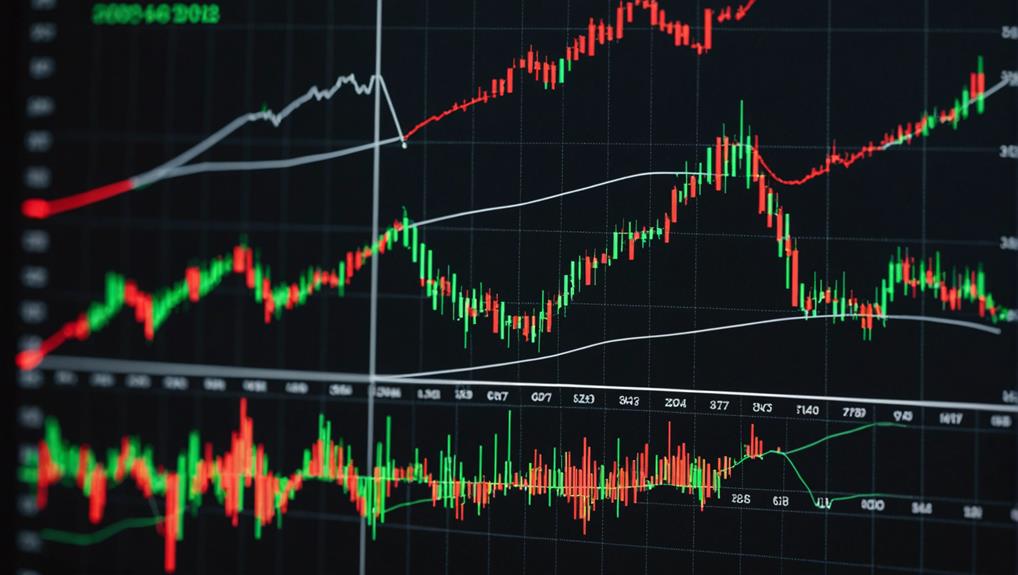To maximize returns, investors must master advanced stock analysis techniques. Beyond basic assessments lie opportunities to harness full potential in today’s dynamic market. By employing fundamental analysis, they evaluate a company’s financial health and intrinsic value using ratios like P/E and ROE. Technical analysis involves studying indicators such as candlestick patterns and moving averages to predict price movements. Quantitative analysis uses statistical modeling and machine learning to enhance decision-making precision. Sentiment analysis tools offer insights into market trends, while industry and sector analysis provide valuable market insights. Embracing diverse risk management strategies guarantees safeguarding in volatile markets.Explore these advanced techniques for optimized returns.
Fundamental Analysis Techniques

Fundamental analysis techniques provide investors with a thorough approach to evaluating a company’s financial health and intrinsic value. By examining financial ratios and economic indicators, investors can make informed decisions about the potential growth and profitability of a company. Financial ratios such as price-to-earnings (P/E) ratio, debt-to-equity ratio, and return on equity (ROE) offer valuable insights into a company’s financial performance and efficiency. These ratios help investors assess how well a company is utilizing its resources and managing its debts.
Economic indicators, on the other hand, provide a broader view of the market conditions that may impact a company’s performance. Indicators like GDP growth rate, unemployment rate, and consumer price index (CPI) can give investors an idea of the overall economic environment in which a company operates. By analyzing these indicators alongside financial ratios, investors can gain a more in-depth understanding of a company’s potential for growth and profitability.
Technical Analysis Strategies
Technical analysis strategies in stock market analysis involve the study of various indicators like candlestick patterns and moving averages. These tools help traders and investors make informed decisions based on historical price movements and trends. By analyzing these patterns and averages, market participants aim to predict future price movements and optimize their trading strategies.
Candlestick Patterns
Understanding the intricacies of Candlestick Patterns is essential for investors seeking to enhance their technical analysis skills in stock market evaluation. Candlestick Patterns, such as the bullish engulfing and bearish harami, provide valuable insights into market sentiment and potential price movements. A bullish engulfing pattern occurs when a large bullish candle completely engulfs the previous bearish candle, signaling a potential reversal to the upside. On the other hand, a bearish harami pattern consists of a small bullish candle contained within the previous large bearish candle, indicating a possible bearish reversal. By recognizing these patterns and understanding their implications, investors can make more informed trading decisions based on the current market dynamics.
Moving Averages
Utilizing moving averages as part of a holistic technical analysis strategy can provide investors with valuable insights into potential price trends and market momentum. By analyzing moving averages, investors can identify trends and potential entry points in the market. Moving averages help smooth out price data over a specified period, making it easier to observe the direction in which a stock is moving. This aids in trend identification and can assist in making informed investment decisions. Additionally, by incorporating moving averages into their analysis, investors can also conduct volatility analysis to better understand the level of risk associated with a particular stock. Ultimately, the use of moving averages can contribute to effective risk mitigation strategies and enhance overall decision-making processes in the stock market.
Quantitative Analysis Methods

Quantitative analysis methods form the bedrock of data-driven stock evaluation, providing investors with statistical modeling techniques to make informed decisions. By utilizing numerical data and statistical tools, investors can gain deeper insights into the historical performance and potential future trends of stocks. This analytical approach allows for a more systematic and objective assessment of investment opportunities, enhancing the precision of stock analysis.
Data-Driven Stock Evaluation
Employing statistical models and historical data, analysts can reveal valuable insights into stock performance through data-driven stock evaluation techniques. Machine learning and predictive analytics play an essential role in analyzing vast amounts of data to identify patterns and trends that can help investors make informed decisions. By leveraging algorithms and mathematical models, analysts can assess stock prices, volatility, and market behavior more accurately. These quantitative methods enable the evaluation of various factors simultaneously, providing a thorough view of a stock’s potential performance. Through data-driven stock evaluation, investors can mitigate risks, optimize portfolio management, and capitalize on market opportunities. By incorporating advanced analytical tools, analysts can enhance their decision-making process and gain a competitive edge in the dynamic world of stock trading.
Statistical Modeling Techniques
Analysts leverage statistical modeling techniques to extract valuable insights from historical data, aiding in a more essential assessment of stock performance. Regression analysis plays an important role in this process by identifying relationships between variables and predicting future stock prices based on historical patterns. By analyzing trends through statistical modeling, analysts can uncover hidden patterns and correlations that may not be apparent through simple observation. This approach enables a more systematic and quantitative evaluation of stock performance, providing investors with valuable information to make informed decisions. Trend forecasting, another key component of statistical modeling, helps analysts anticipate potential market movements and adjust investment strategies accordingly. Overall, statistical modeling techniques offer a robust framework for understanding and predicting stock behavior based on historical data.
Sentiment Analysis Tools
Using advanced sentiment analysis tools, investors can gain valuable insights into market sentiment trends to inform their trading decisions. These tools offer a systematic way to gauge the overall sentiment towards a particular stock or the market as a whole. Here are three key aspects to take into account when utilizing sentiment analysis tools:
- Market Sentiment Tracking: By monitoring market sentiment, investors can understand the prevailing mood among market participants. This can range from extreme fear to overwhelming exuberance, impacting stock prices and creating trading opportunities.
- Sentiment Analysis Indicators: Various indicators, such as social media sentiment, news sentiment, and options market sentiment, can provide valuable data for analysis. These indicators help investors gauge the collective feelings and attitudes towards specific stocks or the market.
- Real-time Insights: Sentiment analysis tools can offer real-time insights, allowing investors to react promptly to changing market sentiment. This agility can be essential in capturing opportunities or mitigating risks in a dynamic market environment.
Industry and Sector Analysis

Effective industry and sector analysis provides investors with valuable insights into the performance and prospects of specific segments within the market. By examining market trends and competitive positioning, investors can make more informed decisions regarding their stock investments. Understanding how different industries and sectors are faring can help investors identify potential opportunities and risks.
A vital aspect of industry and sector analysis is evaluating the competitive landscape. This involves appraising factors such as market share, pricing strategies, innovation, and barriers to entry. By conducting a thorough competitive analysis, investors can determine which companies are well-positioned to outperform others in the industry.
To further illustrate the importance of industry and sector analysis, consider the following table:
| Industry | Market Trends | Competitive Positioning |
|---|---|---|
| Technology | Increasing demand for | Leading companies |
| tech products | investing in R&D | |
| Healthcare | Aging population driving | Strong regulatory |
| healthcare innovation | barriers for new entrants | |
| Energy | Shift towards renewable | Dominance of established |
| energy sources | players in the market |
Analyzing industries and sectors in this manner can help investors maximize returns by capitalizing on emerging trends and selecting companies with strong competitive advantages.
Risk Management Approaches
One must carefully assess and implement diverse risk management approaches to safeguard their investments in the dynamic stock market environment. When considering risk management in stock investments, two key strategies stand out:
- Portfolio Diversification: Spreading investments across different asset classes, industries, and geographic regions can help mitigate the impact of adverse events affecting any single investment. This strategy aims to reduce overall portfolio risk by not putting all eggs in one basket.
- Volatility Monitoring: Keeping a close eye on the volatility of individual stocks and the overall market can provide valuable insights into potential risks. By understanding and tracking volatility trends, investors can make more informed decisions about when to enter or exit positions to manage risk effectively.
- Risk Assessment Tools: Utilizing risk assessment tools and metrics can aid in quantifying and evaluating the level of risk within a portfolio. Metrics such as beta, standard deviation, and value at risk (VaR) can help investors better understand the risk-return profile of their investments.